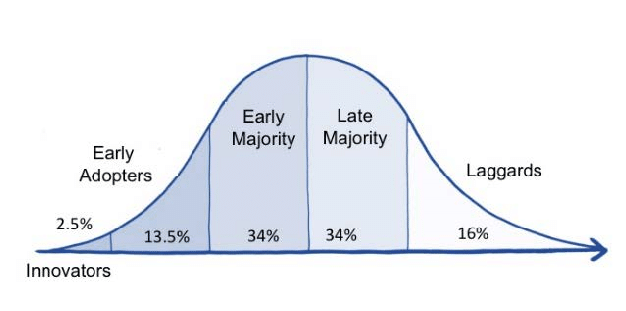Audience vs. Community: What's the Difference?

Audience and community are similar enough they basically seem to be the same thing. In reality, this is quite far from the truth.
In this article, we're going to dive into the definitions of audience and community, the differences between the two, and how building a community may be more advantageous in the long run.
Let's dive in!
The definition of audience
When you think of an audience, a crowd at a music festival or people watching their favorite YouTube star might come to mind. At the core, that's exactly what an audience is.
An audience is a group of people interested in what a specific person or group has to share. Your Twitter, Instagram, or TikTok followers are an audience. You also are my audience because you're reading this blog post. (Thanks for reading, by the way!)
The characteristic that makes an audience is the one-to-many relationship between the sharer and the group of people interested. Think of it like broadcasting. A YouTube video you're watching is conveying the same information to everyone else watching it, too. As a viewer, you're interested in what the person is saying over connecting with the other people also watching the same thing.
The definition of community
The group of friends you play board games with every Friday night. The message board where you share thoughts about your favorite product. The chat room discussing something you're passionate about. These are all examples of communities.
There are two aspects that make a community a community:
- a shared desire to connect with one another
- a place to come together
A community is a group of people coming together for a common purpose, interest, or vision. While many communities form in-person, some come together online. The whole point of a community is to connect people. It's a many-to-many relationship; while there may be a single leader of a community, their job is to create that place where connections happen.
Audience and community are often confused
By these definitions, it might already be clear that community and audience are two different things. Instead, they're often confused and used interchangeably.
Many times, when a creator or business is looking to build a "community", they want to increase their brand awareness, get the word out to more people, and expand their reach. With our definitions in mind, that's building an audience, not a community.
This isn't always a bad thing. As Noele Flowers puts it nicely in her article discussing the difference of these terms:
Semantic debates can often feel like a stick in the mud, but I take an overall positive view toward this discussion—I want to posit that when brands draw a false equivalency between community and audience, this is actually a good sign. Why? Because if a company is opting to use the word “community” to describe their audience overall, that likely means that they see some value in connecting with their audience in a more personal way, building stronger identification with their brand for their members, and creating connections amongst their members based on shared attributes.
Why? Because if a company is opting to use the word “community” to describe their audience overall, that likely means that they see some value in connecting with their audience in a more personal way, building stronger identification with their brand for their members, and creating connections amongst their members based on shared attributes.
Stated otherwise -- many companies see their audience as their community, and while that can cause some difficulties, there is at least a surface understanding that deeper connections with audience members are valuable.
There are some challenges that often come from this confusion, however. Job titles in the community profession are often mashed together due to the mix-up. Social media managers get tagged with community management tasks and vice versa -- despite the fact these two positions largely require different skillsets.
There isn't a clear understanding of where the lines are. Let's unpack the differences a bit further to help draw those boundaries.
Differences between audience and community
The distinction between community and audience is confusing in part because your community is a segment of your audience. More correctly, your community is where your most interested audience members go to connect with one another.
That also raises an important point – an engaged audience is different from an engaged community. Engaged audiences will consume, like, and share the content published through different channels, whether that's a blog, social media, or YouTube. On the other hand, an engaged community participates in creating a shared space. Members often make their own content with a desire to connect with the leader of the tribe and other members.
Here's another way to think about it.

Rogers adoption curve is a way to visualize how ideas are adopted by the population. Innovators and early adopters will catch your idea first. As that idea gains popularity, it will gain adoption in the early majority (if you're lucky).
Broadcasting to an audience is casting a wide net. You're seeking to "get the word out" about your idea to as many people as possible, but really you're looking for early adopters. The more the word gets out, the more early adopters who find you.
Even if you find those early adopters, how will they engage? Do you simply want them to engage with what you share? Sure, some of them may become customers or subscribe to whatever you publish, but where do they go next?
That's really where a community comes in. Many times, these innovators and early adopters want to become part of the process. They want to stay in touch. Some even want to help get the word out to other early adopters through their own platforms. Building a community gives these innovators and early audience members a place to call home. Having an audience is an effective way to get the word out, but these early adopters need a place to land.
Advantages to Building a Community vs Audience
There are a number of advantages to building a community out of your audience besides simply giving them a place to connect.
With community platforms like Discourse, you have total ownership. You don't want your community building efforts on social media to end up fruitless because the platform decides to change their algorithm or available features. With a dedicated community platform, your community truly has a place to call their own.
Creators in particular can benefit from building a community. People will often pay for a special, private place to connect with others who share the same interest. Amanda Palmer's community is one such example, where patrons get special access to a forum by supporting her on Patreon.
This benefit extends well beyond creators. Product-focused communities gather direct feedback from those using the product -- leading to user generated product improvements. UiPath's community and our own Discourse Meta are two examples of this type of community.
Support communities are also a key way organizations can scale support for their products and improve customer service. Not only can your support staff engage with members seeking help, but members are empowered to help one another as well.
A difference in engagement
The difference between an audience and a community is simple. You must engage audiences, but communities engage with you on their own. Whatever venture you're pursuing, there are distinct advantages to building a community from your audience.
What are you pursuing? Did I miss anything? Let me know in the discussion linked below.
